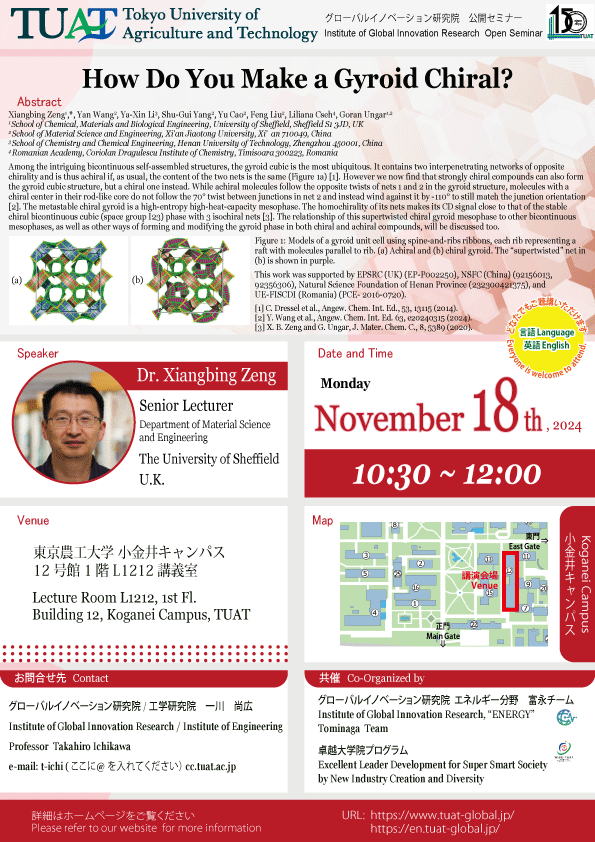イベント情報
【GIR公開セミナー】Dr. Xiangbing Zeng / シェフィールド大学(英国)

| 日時 | 2024.11.18(10:30~12:00) |
|---|---|
| 会場 | |
| 講演者 | Dr. Xiangbing Zeng |
| 所属機関 | シェフィールド大学 (英国) |
| 講演タイトル | "How Do You Make a Gyroid Chiral?" <要旨> Xiangbing Zeng1,*, Yan Wang2, Ya-Xin Li3, Shu-Gui Yang2, Yu Cao2, Feng Liu2, Liliana Cseh4, Goran Ungar1,2 1, School of Chemical, Materials and Biological Engineering, University of Sheffield, Sheffield S1 3JD, UK 2, School of Material Science and Engineering, Xi'an Jiaotong University, Xi’an 710049, China 3, School of Chemistry and Chemical Engineering, Henan University of Technology, Zhengzhou 450001, China 4, Romanian Academy, Coriolan Dragulescu Institute of Chemistry, Timisoara 300223, Romania Among the intriguing bicontinuous self-assembled structures, the gyroid cubic is the most ubiquitous. It contains two interpenetrating networks of opposite chirality and is thus achiral if, as usual, the content of the two nets is the same (Figure 1a) [1]. However we now find that strongly chiral compounds can also form the gyroid cubic structure, but a chiral one instead. While achiral molecules follow the opposite twists of nets 1 and 2 in the gyroid structure, molecules with a chiral center in their rod-like core do not follow the 70° twist between junctions in net 2 and instead wind against it by -110° to still match the junction orientation [2]. The metastable chiral gyroid is a high-entropy high-heat-capacity mesophase. The homochirality of its nets makes its CD signal close to that of the stable chiral bicontinuous cubic (space group I23) phase with 3 isochiral nets [3]. The relationship of this supertwisted chiral gyroid mesophase to other bicontinuous mesophases, as well as other ways of forming and modifying the gyroid phase in both chiral and achiral compounds, will be discussed too. (a) see the poster (b) see the poster Figure 1: Models of a gyroid unit cell using spine-and-ribs ribbons, each rib representing a raft with molecules parallel to rib. (a) Achiral and (b) chiral gyroid. The “supertwisted” net in (b) is shown in purple. This work was supported by EPSRC (UK) (EP-P002250), NSFC (China) (92156013, 92356306), Natural Science Foundation of Henan Province (232300421375), and UE-FISCDI (Romania) (PCE- 2016-0720). [1] C. Dressel et al., Angew. Chem. Int. Ed., 53, 13115 (2014). [2] Y. Wang et al., Angew. Chem. Int. Ed. 63, e20240315 (2024). [3] X. B. Zeng and G. Ungar, J. Mater. Chem. C., 8, 5389 (2020). |
| 言語 | 英語 |
| 対象 | どなたでも、ご参加いただけます。 |
| 共催 | グローバルイノベーション研究院 エネルギー分野 富永 チーム 卓越大学院プログラム |
| お問い合わせ窓口 | グローバルイノベーション研究院・工学研究院 一川 尚広 e-mail: t-ichi (ここに@ を入れてください ) c.tuat.ac.jp |
| 備考 | 本セミナーは、対面型のみの開催となります。 |
このページの上部へ